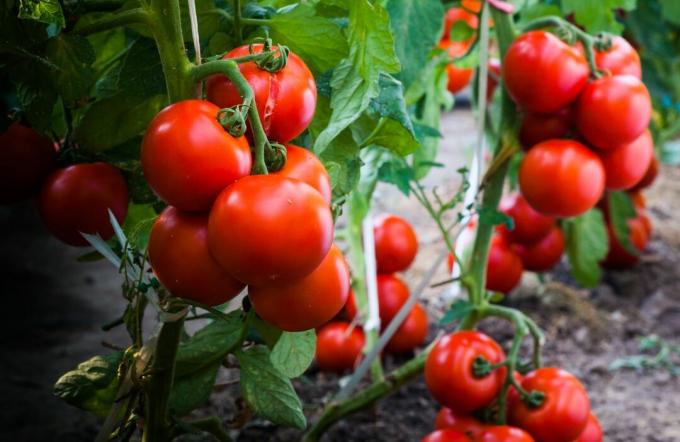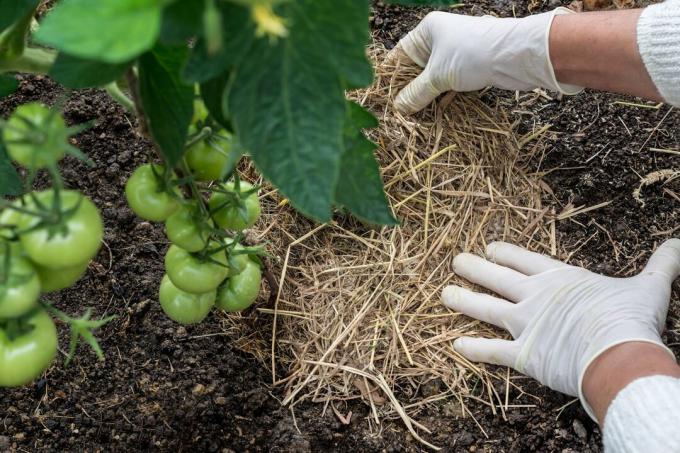When and how often should you water tomatoes? Why can it be worth mulching tomatoes? We reveal everything about mulching and watering the red fruits.

In summer you can watch your own tomatoes grow: they begin to bloom and then bear the first small, green fruits. Now the time begins when you have to pay particular attention to the water balance of the delicious fruits. The tomato places high demands on nutrient and water availability, which are not always easy to meet in midsummer. There are a few things to consider when watering and mulching. In this article we have put together tips for you to get the thirsty plants through the summer.
contents
- When and how often to water tomatoes?
-
Mulch tomatoes
- Why Should You Mulch Tomatoes?
- The right time to mulch tomatoes
- How and with what do you mulch tomatoes?
- Fertilize tomatoes during the growth phase
When and how often to water tomatoes?
The plants should be watered regularly and preferably in the morning rather than in the evening. In general, tomatoes, like other heat-loving plants, prefer tempered to lukewarm (rain) water to cold and too calcareous tap water. During the day, the plants dry well and are better protected from fungal diseases. In midsummer you have to water several times, especially with potted plants, because the soil dries out particularly quickly here. In the greenhouse, the moisture in the soil stays much longer, and here you can only water heavily every two days. It is very important never to water the plants completely, the leaves should not be wetted with the irrigation water. Instead, you deliver a generous gush to the trunk just above the ground. Wet leaves - and moisture in general - facilitate the spread of all sorts of diseases. Pests that live in the soil are also distributed directly on the plant with the "overhead" method when watering with the spray water.
Even if many hobby gardeners may not believe it, watering adapted to tomatoes really pays off. Our tips summarized again:
- Water in the morning to allow the plants to dry off during the day.
- Water regularly with temperate rainwater.
- Never pour tomatoes over them, only water at the base of the stem.

tip: With proper watering you can environmental and physiological tomato damage prevent. You can find out more about this in our special article.
Mulch tomatoes
Mulch is generally material that is used to cover the surface of exposed soil.
One distinguishes between:
- Artificial mulch materials such as plastic or gravel
- Organic materials such as plant parts, compost or tree bark
Here we only want to devote ourselves to organic mulches, as they are sustainable and have particularly positive properties on the soil.
Why Should You Mulch Tomatoes?
Mulch made from plant material such as straw, grass clippings or the like inhibits weed growth and retains moisture in the soil. Soil organisms gradually decompose the plant debris, releasing nutrients that tomatoes like to feed on. Tomatoes with mulch grow better, are often healthier and the soil underneath is less stressed. The thirsty tomatoes need to be watered less often because the mulch inhibits evaporation even on hot summer days. Mulch actively improves the soil structure and protects the soil from compaction and erosion caused by wind and rain.

The right time to mulch tomatoes
In principle, mulching is worthwhile throughout the season; the first mulching specifically for tomatoes is best done in March or April. If the soil has already warmed up a little, the mulch layer also stores the heat and prepares the soil for the tomatoes' roots, which are sensitive to the cold. In addition, it rains more often in spring and part of the mulch can be processed into humus in the soil. Nutrients are then immediately available for the tomato plants that follow in May. Once the tomatoes are transplanted, add a little bit of plant matter to the mulch layer periodically to keep the soil thinly covered.
How and with what do you mulch tomatoes?
Depending on the plant material, cover the soil with a layer two to five centimeters thick. The more delicate the plants are, the finer the material should be. Leave some space around the stem of the tomato. Mulch that is piled up too thick could rot and make the plants sick. Compost that has not yet fully decomposed can be placed around the plant. This is worked into the soil, which not only improves the supply of nutrients, but also loosens the soil itself. In addition, some manure and horn shavings from organic farming can also be incorporated.
Even nettles, which are usually weeded anyway, are ideal for mulching. They can be distributed as whole plants on the topsoil, or crushed, then they are digested more quickly by the soil organisms. As these are gradually broken down, nitrogen is released for the tomato plant to grow. However, you should avoid using acidic bark mulch with tomatoes.
The mulch layer influences tomato growth in three ways. On the one hand, less water evaporates, which means that the soil remains moist. This is because stress caused by drought leads to a reduced harvest. The mulch also stores heat during the day and releases it at night. Last but not least, mulch supports the even, natural nutrient supply that combines with a primarily organic long-term fertilizer for a rich harvest of the colorful fruits cares.
Fertilize tomatoes during the growth phase
Balanced fertilization is also important for tomato cultivation. Because if you fertilize too little, the yield suffers. If you overdo it, the plants become more susceptible to disease and develop poor-tasting fruits. Therefore, a primarily organic long-term fertilizer such as our Plantura is ideal for tomatoes Organic Tomato Fertilizer which regularly releases balanced amounts of nutrients. If you grow tomatoes in pots, you can also use an organic liquid fertilizer like ours every one to two weeks Plantura Organic Tomato & Vegetable Fertilizer administer over the irrigation water. In this way, you can take preventive action against deficiency symptoms, such as yellowing of the lower leaves due to a lack of nitrogen. If there is already a nutrient deficiency, the organic liquid fertilizer works particularly quickly and nourishes the plant again.
More on how to make your Fertilize tomatoes properly, you can find out in our special article.


